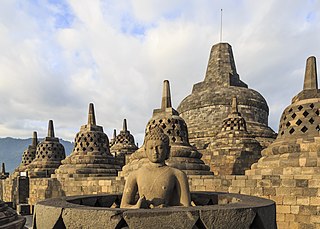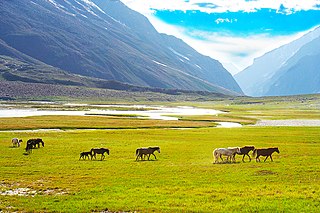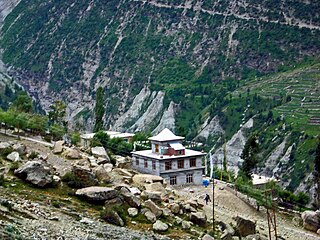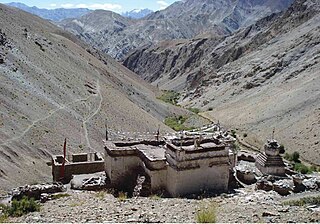
In Buddhism, Avalokiteśvara, also known as Avalokitasvara, is a bodhisattva who contains the compassion of all Buddhas and is the principal attendant of Amitabha Buddha on the right. He has 108 avatars, the most notable of which is Padmapāṇi. He is variably depicted, described, and portrayed as either male or female in different cultures. Guanyin is one of the female depictions of Avalokiteśvara that appears in East Asia.

Drikung Kagyü or Drigung Kagyü is one of the eight "minor" lineages of the Kagyu school of Tibetan Buddhism. "Major" here refers to those Kagyü lineages founded by the immediate disciples of Gampopa (1079-1153), while "minor" refers to all the lineages founded by disciples of Gampopa's main disciple, Phagmo Drupa (1110-1170). One of these disciples, Jigten Sumgön (1143-1217), is the founder of Drikung.

Buddhist religious architecture developed in the Indian subcontinent. Three types of structures are associated with the religious architecture of early Buddhism: monasteries (viharas), places to venerate relics (stupas), and shrines or prayer halls, which later came to be called temples in some places.

Ladakh has a long history with evidence of human settlement from as back as 9000 b.c. It has been a crossroad of high Asia for thousands of years and has seen many cultures, empires and technologies born in its neighbours. As a result of these developments Ladakh has imported many traditions and culture from its neighbours and combining them all gave rise to a unique tradition and culture of its own.

The Suru Valley is a valley in the Kargil District in the Union Territory of Ladakh, India. It is drained by the Suru River, a tributary of the Indus River. The valley's most significant town is Sankoo.

Tourism is one of an economic contributor to the union territory of Ladakh in Northern India. The union territory is sandwiched between the Karakoram mountain range to the north and the Himalayas to the south and is situated at the height of 11,400 ft. Ladakh is composed of the Leh and Kargil districts. The region contains prominent Buddhist sites and has an ecotourism industry.

Lamayuru or Yuru Monastery is a Tibetan Buddhist monastery in Lamayouro, Leh district, Ladakh, India. It is situated on the Srinagar-Leh highway 15 kilometres (9.3 mi) east of the Fotu La at a height of 3,510 metres (11,520 ft) and 19 km southwest of Khalsi.

Thiksey Monastery or Thiksey Gompa is a Buddhist monastery affiliated with the Gelug school of Tibetan Buddhism. It is located on top of a hill in Thiksey approximately 19 kilometres (12 mi) east of Leh, in the Ladakh region of northern India. It is noted for its resemblance to the Potala Palace in Lhasa, Tibet, and is the largest monastery in central Ladakh, notably containing a separate set of buildings for female renunciates that has been the source of significant recent building and reorganization.

Lingshed Monastery or Lingshed Gompa is a Gelugpa Buddhist monastery in Ladakh, India. It is located near Lingshet village in the Leh district. It is 84 km north of Padum. It was founded in the 1440s by Changsems Sherabs Zangpo, disciple of Je Tsongkhapa, on a monastic site previously founded by the Translator Rinchen Zangpo. The monastery has belonged to the religious estate of Ngari Rinpoche since 1779. The Jangchub Tensung Dorje Center was founded in Lingshed by Kyabje Dagom Rinpoche in 1994.

Gandhola Monastery is about 18 kilometres (11 mi) before Keylong in Lahaul and Spiti district, Himachal Pradesh, India on the road from Manali, Himachal Pradesh. It is located on a hill above Tupchiling Village at the sacred junction of the Chandra and Bhaga rivers, which together form the Chenab River. The village is at 3,160 m (10,370 ft) and is famous for its 7-storey tower fort.

Likir Monastery or Likir Gompa (Klud-kyil) is a Buddhist monastery in Ladakh, Northern India. It is located at 3700m elevation, approximately 52 kilometres (32 mi) west of Leh. It is picturesquely situated on a little hill in the valley, in Likir village near the Indus River about 9.5 kilometres (5.9 mi) north of the Srinigar to Leh highway. It belongs to the Gelugpa sect of Tibetan Buddhism and was established in 1065 by Lama Duwang Chosje, at the command of the fifth king of Ladakh, Lhachen Gyalpo (Lha-chen-rgyal-po). It is off the Leh-Kargil Highway, 50 km west of Leh between Alchi & Basgo, 17 km west of Basgo Monastery & 21 km northeast of Alchi Monastery.

Phyang Monastery, Phyang Gompa is a Buddhist monastery located in Fiang village, just 15 or 16 kilometres west of Leh in Ladakh, northern India. It was established in 1515.

Sankar Monastery, or Sankar Gompa is a Buddhist monastery within an easy half-hour walk from Leh in Ladakh, northern India. It is a daughter-establishment of the Spituk Monastery and the residence of the Abbot of Spituk, the Venerable Kushok Bakula, who is the senior incarnate lama of Ladakh due to his ancient lineage and personal authority.

Basgo Monastery, also known as Basgo or Bazgo Gompa, is a Buddhist monastery located in Basgo or Bazgo on the bank of Indus river in Leh District of Ladakh in northern India approximately 5 km west of Nimoo and 40 km east from Leh. Although the monastery was built for the Namgyal rulers in 1680, Bazgo itself was embedded in the early days of Ladakh and is frequently mentioned in the Ladakhi Chronicles when it was a political and cultural center. In the 15th century, a palace was built in Basgo.

Stakna Monastery or Stakna Gompa is a Buddhist monastery of the Drugpa sect in Stakna, Leh district, Ladakh, northern India, 21 or 25 kilometres from Leh on the left bank of the Indus River.

Stok Monastery or Stok Gompa is a Buddhist monastery in Stok, Leh district, Ladakh, northern India, 15 kilometres south of Leh. It was founded by Lama Lhawang Lotus in the 14th Century and has a notable library including all 108 volumes of the Kangyur. A ritual dance-mask festival is held annually.

Alchi Monastery or Alchi Gompa is a Tibetan Buddhist monastery, known more as a monastic complex (chos-'khor) of temples in Alchi village in the Leh District, under the Ladakh Autonomous Hill Development Council of the Ladakh Union Territory. The complex comprises four separate settlements in the Alchi village in the lower Ladakh region with monuments dated to different periods. Of these four hamlets, Alchi monastery is said to be the oldest and most famous. It is administered by the Likir Monastery. It is 60 west of Leh on Leh-Kargil Highway.

Temple at Sumda Chun, an early Tibetan Buddhist temple and monastery is located in the Sumda Chun village, on northwest edge of Leh in Himalayas in Ladakh, India.
All Ladakh Gonpa Association (ALGA) is the central organisation of the Buddhist monasteries in Ladakh, India. It aims to preserve and strengthen the monastic institutions. It was founded by the 19th Kushok Bakula Rinpoche in 1949 and he acted as its president for 41 years, from 1949 until 1991. In 1949, the first meeting of the great monasteries was held and ten monasteries took part. All Ladakh Gonpa Association was registered in 1959 and is run by a governing body consisting of fifteen lama members belonging to all four major schools of Tibetan Buddhism. There are sixteen major monastic institutions with hundreds of monks in each monastery.

The culture of Ladakh refers to the traditional customs, belief systems, and political systems that are followed by Ladakhi people in India. The languages, religions, dance, music, architecture, food, and customs of the Ladakh region are similar to neighboring Tibet. Ladakhi is the traditional language of Ladakh. The popular dances in Ladakh include the khatok chenmo, cham, etc. The people of Ladakh also celebrate several festivals throughout the year, some of the most famous are Hemis Tsechu and Losar.
Neuwirth, Holger & Auer, Carmen (Hrsg.) „The Three Storied Temple of Wanla", Buddhist Architecture in the Western Himalayas, Band 2, Verlag der Technischen Universität Graz, 2015, 205 S., ISBN 978-3-85125-391-7





















